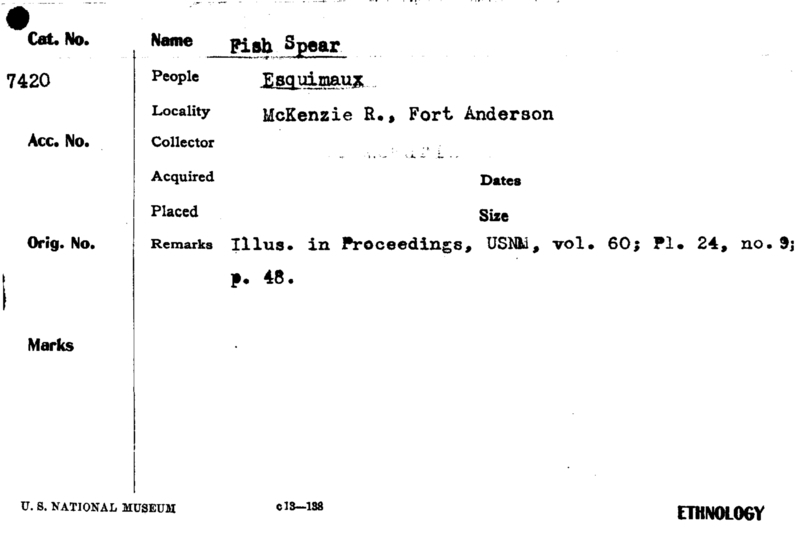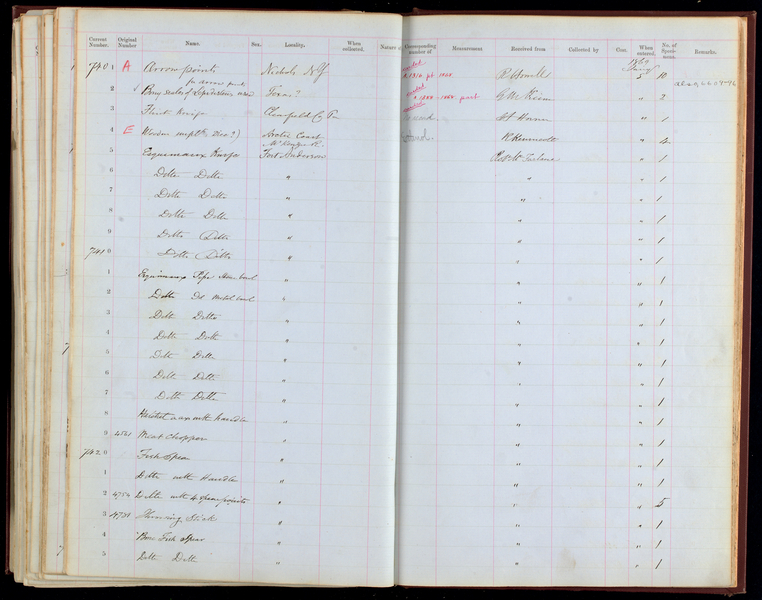Fish Spear Item Number: E7420-0 from the National Museum of Natural History







Notes
FROM CARD: "ILLUS. IN PROCEEDINGS, USNM, VOL. 60; PL. 24, NO. 9; P. 48." FROM 19TH OR EARLY 20TH CENTURY EXHIBIT LABEL WITH CARD: "ADJUSTABLE SPEAR-HEADS.-CONSIST OF TWO PARTS: A CARVED, BARBED BONE, WHICH IS POINTED AND FITS INTO HEAD OF WOODEN SHAFT, AND A METAL HEAD, BARBED, WHICH IS LASHED IN A SLOT IN OUTER END OF THE BONE HEAD. FROM ANDERSON RIVER. LENGTHS, 6 1/2 INS. TO 1 FT. 2 INS. BRITISH AMERICA, 1867. COLLECTED BY ROBERT [SIC, SHOULD BE RODERICK] MACFARLANE. NOS. 7,420, 2,431, AND FOUR SPECIMENS, NO. 2,675."Note that 7420 is mentioned as being used in an exhibit in Berlin in 1880 on p. 60 of USNM Bulletin No. 18.Source of the information below: Inuvialuit Pitqusiit Inuuniarutait: Inuvialuit Living History, The MacFarlane Collection website, by the Inuvialuit Cultural Resource Centre (ICRC), Inuvik, N.W.T., Canada (website credits here http://www.inuvialuitlivinghistory.ca/posts/12 ), entry on this artifact http://www.inuvialuitlivinghistory.ca/items/111 , retrieved 1-27-2020: Dart head made from whalebone. It has two barbs along one edge, and an iron blade set into a slot at one end and held in place with an iron rivet. The other end tapers to a rounded point where it would have been inserted into a socket at the end of a shaft. Near that end a hole has been drilled for attaching a line. The Smithsonian Institution's catalogue card identifies this item as a fish spear, but more likely it is a head for a dart used for hunting sea mammals. More information here: http://www.inuvialuitlivinghistory.ca/item_types/38: Darts are used for hunting sea mammals such as seals and whales. Darts have a barbed point that is inserted into a socket at the end of a shaft. The dart head detached from the shaft and stays attached to an animal when it is struck. A line fastened to the dart head is secured at the other end to a float or to the shaft.
Item History
- Made in Northwest Territories, Canada
- Collected by Roderick R. MacFarlane in Northwest Territories, Canada
- Received on January 7, 1869
What
- Name
- Fish Spear
- Identification Number
- E7420-0
- Type of Item
- dart
Who
- Culture
- Eskimo, Inuit and Inuvialuk
- Field Collector
- Roderick R. MacFarlane
Where
- Holding Institution
- National Museum of Natural History
- Made in
- Northwest Territories, Canada
- Collected in
- Northwest Territories, Canada
When
- Acquisition Date
- on January 7, 1869
Other
- Accession Number
- 69A00012